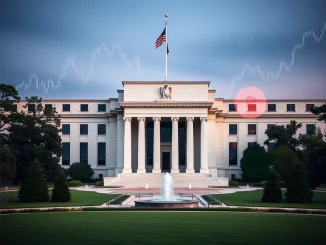
The tremors of the March 2023 bank failures are still being felt across the financial landscape, especially within the crypto industry. Now, a prominent voice, Fed Governor Michelle Bowman, is stepping forward, demanding an independent probe into these critical events. Why is this significant, and what could it mean for the future of financial regulation and crypto banks? Let’s dive into the details of Bowman’s call for transparency and accountability.
Why is Fed Governor Bowman Calling for an Independent Probe into Bank Failures?
Fed Governor Bowman, a contender for the influential position of vice chair for supervision, didn’t mince words during a recent House Financial Services Committee hearing. She voiced strong support for an external, impartial review of the events that led to the collapse of several banks in March 2023. While she refrained from naming names publicly, it’s widely understood that she was referring to the dramatic failures of Silicon Valley Bank (SVB), Silvergate Bank, and Signature Bank – institutions with significant ties to the cryptocurrency sector.
But why is Bowman pushing for an independent probe, especially when the Federal Reserve already conducted an internal review led by Michael Barr? Bowman’s critique is sharp and pointed:
- Self-Serving Review: Bowman characterized Barr’s internal review as “self-serving.” This suggests a concern that the internal investigation might have been biased towards protecting the Fed’s own reputation and actions, rather than providing a truly objective analysis.
- Exclusion of Governors: She highlighted that other Fed governors were excluded from contributing to Barr’s review. This lack of inclusivity raises questions about the thoroughness and comprehensiveness of the internal investigation. Were diverse perspectives and crucial insights missed?
Essentially, Fed Governor Bowman is advocating for a transparent and unbiased examination of the bank failures. She believes that a truly independent probe, free from internal biases and limitations, is necessary to understand what went wrong and to prevent similar crises in the future.
What Were the 2023 Bank Failures and Why Do They Matter to Crypto?
The March 2023 bank failures sent shockwaves through the financial world, and the crypto industry felt the reverberations particularly strongly. Let’s recap the key events:
- Silvergate Bank: A crypto-friendly bank, Silvergate announced its voluntary liquidation in early March, citing market volatility and a loss of confidence. This immediately raised concerns about the stability of other banks serving the crypto sector.
- Silicon Valley Bank (SVB): SVB’s rapid collapse was triggered by a classic bank run. Concerns about its financial health led to massive withdrawals by depositors, overwhelming the bank’s liquidity and leading to its seizure by regulators. While not exclusively a crypto bank, SVB had significant exposure to tech startups, many of which are involved in crypto and blockchain.
- Signature Bank: Just days after SVB, Signature Bank also faced a bank run and was taken over by regulators. Signature Bank was known for its crypto-friendly stance and had a substantial deposit base from crypto companies.
These bank failures were significant for several reasons, especially for the crypto ecosystem:
| Impact Area | Description |
|---|---|
| Contagion Fears | The rapid succession of failures sparked fears of contagion across the banking system, particularly for institutions heavily involved with digital assets. |
| Liquidity Crunch | The failures highlighted the potential for liquidity risks in banks serving the crypto industry, especially during periods of market stress. |
| Regulatory Scrutiny | These events intensified regulatory scrutiny of the crypto industry and the banks that serve it. Regulators are now even more focused on financial regulation and risk management within the crypto space. |
| Investor Confidence | The bank failures eroded investor confidence in the crypto market, at least temporarily. It underscored the interconnectedness of traditional finance and the digital asset world. |
What Could an Independent Probe Uncover About Financial Regulation?
An independent probe into the bank failures has the potential to uncover critical insights into the effectiveness of current financial regulation and supervisory practices. What are some key areas an investigation might explore?
- Supervisory Lapses: Did regulators, including the Federal Reserve, adequately supervise these banks? Were there early warning signs that were missed or ignored? An independent probe can objectively assess the supervisory actions taken (or not taken) leading up to the crises.
- Risk Management Failures: Did the banks themselves have adequate risk management practices in place, particularly concerning liquidity risk and interest rate risk? Were these practices effectively implemented and monitored?
- Impact of Interest Rate Hikes: The rapid increase in interest rates by the Federal Reserve in 2022 and 2023 is widely cited as a contributing factor to the bank failures. An independent probe could analyze how these rate hikes interacted with the banks’ balance sheets and risk profiles.
- Regulatory Gaps for Crypto Banks: Are there specific regulatory gaps or weaknesses in the oversight of crypto banks and institutions dealing with digital assets? The probe could identify areas where financial regulation needs to be strengthened to address the unique risks associated with the crypto industry.
- Communication and Coordination: How effective was the communication and coordination between different regulatory agencies during the crisis? Were there breakdowns in communication that exacerbated the situation?
The Path Forward: Strengthening Financial Regulation and Oversight
Fed Governor Bowman‘s call for an independent probe is a crucial step towards learning from the 2023 bank failures and strengthening the financial regulation framework. What actionable steps can be taken based on the findings of such an investigation?
- Enhanced Supervision: Regulators may need to enhance their supervisory practices, particularly for banks with significant exposure to specific sectors like crypto. This could involve more frequent examinations, stricter capital requirements, and closer monitoring of liquidity risks.
- Updated Regulations: The independent probe might recommend updates to existing financial regulation to better address the evolving risks in the banking sector, including those related to digital assets. This could involve clarifying regulatory perimeters for crypto banks and stablecoins.
- Improved Risk Management Standards: Banks themselves need to continuously improve their risk management practices. This includes stress testing for various scenarios, robust liquidity management, and effective interest rate risk management.
- Increased Transparency and Accountability: An independent probe promotes transparency and accountability. The findings and recommendations should be made public to foster trust in the regulatory system and encourage responsible behavior by financial institutions.
- Industry Collaboration: Open dialogue and collaboration between regulators, crypto banks, and the broader crypto industry are essential. This can help in developing effective and balanced financial regulation that supports innovation while mitigating risks.
Conclusion: A Critical Juncture for Financial Stability
Fed Governor Bowman‘s demand for an independent probe into the 2023 bank failures marks a critical juncture. It’s not just about looking back at what went wrong; it’s about proactively shaping a more resilient and robust financial system for the future. For the crypto industry, this could mean a more clearly defined and stable regulatory landscape, fostering responsible growth and innovation. The outcome of this call for scrutiny could have profound implications for the future of financial regulation, crypto banks, and the broader financial world. The push for an independent probe signals a commitment to learning from past mistakes and building a stronger, more secure financial future for all.



